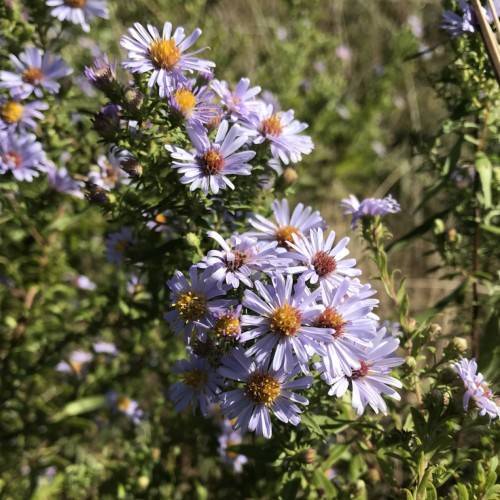
aster
Symphyotrichum praealtum
Cycle:
Herbaceous Perennial
Watering:
Frequent
Hardiness Zone:
4 - 8
Flowers:
Flowers
Sun:
Full sun,part shade
Leaf:
Yes
Growth Rate:
Low
Maintenance:
Low
Drought Tolerant:
Yes
Salt Tolerant:
Yes
Care Level:
Medium
watering
Asters should be watered regularly, but take care not to overwater. Aim for moist, well-draining soil that is never soggy. Asters should be watered every 7-10 days, depending on temperature and soil moisture. Water the base of the plant until the soil is damp 2 to 3 inches below the surface. Avoid wetting the foliage, as this can cause fungal diseases. During hot and dry periods, Asters may need to be watered more frequently.
sunlight
Aster plants need plenty of sunlight to thrive best. When grown in full sun, an aster can produce larger, more vibrant flowers. It's recommended that asters get at least 5 to 6 hours of sunlight a day. If grown in partial shade, they should receive the remainder of their light from indirect sunlight in order to get the full 6 hours. For best results, asters should be planted in an area that receives sun for most of the day. Additionally, asters can benefit from being planted in the sunniest location in the yard to ensure they’re getting enough sunlight.
pruning
Aster plants should be pruned twice a year. Once at the beginning of the growing season in spring (March-April or just after flowering, depending on the region), and again in late summer or fall (August-September) to remove spent blooms and reduce the size of the plant if necessary. Pruning should be light and just enough to prevent the plant from becoming overgrown. When pruning for size reduction, do not remove more than 1-third of its total height. This will create a fuller, bushier plant that will produce a gorgeous display of blooms in the early fall.
Season
Hardiness Map
FAQ
Is gerbera a member of the Asteraceae family?
Yes, gerbera (Gerbera jamesonii) is a member of the Asteraceae family, commonly known as the daisy, sunflower, or composite family. Gerbera is a genus of about 30 species of flowering plants native to tropical regions of South America, Africa, and Asia. They are grown as ornamental garden and indoor plants, earning them the popular nickname "Gerber Daisy." They usually have a long flowering season and can come in a variety of colors, making them a popular choice for bouquets and floral arrangements.
Do aster flowers attract butterflies and bees?
Yes, aster flowers definitely attract butterflies and bees. Asters are bright, bold garden favorites due to their delicate blossoms, which often feature curved petals that fan out like a star. Their colors range from violet and purple to pink, white, and blue, so they offer a wide range of colors that attract butterflies and bees. Additionally, aster flowers are usually clustered close together, which providesa perfect landing spot for both butterflies and bees.
Is aster flower a good option for landscape design?
Aster flowers are an excellent option for landscape design because of their bright color, attractive shape, and ease of maintenance. Asters have deep colorings that range from purple, to white, to pink, with some varieties having variegated petals. They also come in multiple heights and widths, which makes it easy to fit them into your landscape plan. Finally, asters are quite low-maintenance, only requiring occasional trimming and occasional fertilizing for optimal growth.
Should aster flowers be grown in pots or in the ground?
Aster flowers can be grown both in pots and in the ground depending on the needs of the gardener. When grown in the ground, asters provide homeowners with a stunning border for flower beds or a vibrant addition to any garden. For those who prefer to have plants that move with them, or have limited outside space, asters can be grown in pots. Asters do need well-draining soil and adequate sunlight when planted outdoors, and a larger pot size will be needed to accommodate their deep roots. Whichever method you choose, make sure that your potted or in-ground asters receive the proper care and maintenance to keep them blooming brightly.
Is the aster flower a perennial or an annual plant?
The aster flower is a perennial plant, meaning that it will regrow each year for multiple years. Asters bloom in late summer and fall and can range in color from white and pale pink to deep purple. They are popular flowers for outdoor and indoor gardens, and since they are fairly hardy, they can thrive in a range of soils and temperatures.
Do aster flowers have a strong scent?
Aster flowers typically have a mild scent, though some varieties, such as the purple aster, may have a slightly stronger one. Astilbes, which are closely related to asters, are known to have a more "fragrant" smell. But overall, asters typically do not have an overpowering fragrance.
Should aster flowers be planted in the fall or spring?
Aster flowers should be planted in the fall. By planting asters in the fall, their roots will have time to become established during the colder winter months. This gives the flowers a head start when the warmer spring weather arrives. The blooms will then flower for several weeks. If asters are planted in the spring, they may not have enough time to become firmly established, compromising the flower's longevity and bloom size.
Could aster flowers grow in a rock garden?
Aster flowers can absolutely be grown in a rock garden. They are versatile and are able to adapt to many different growing conditions. The plants thrive in well-drained soil and appreciate the heat reflected off of rocks and stones. A moderate supply of water is required, so regular watering will be necessary. Rock gardens are becoming increasingly popular, and aster flowers are an ideal choice for this type of garden because of their bright colors and long lasting blooms.
